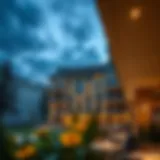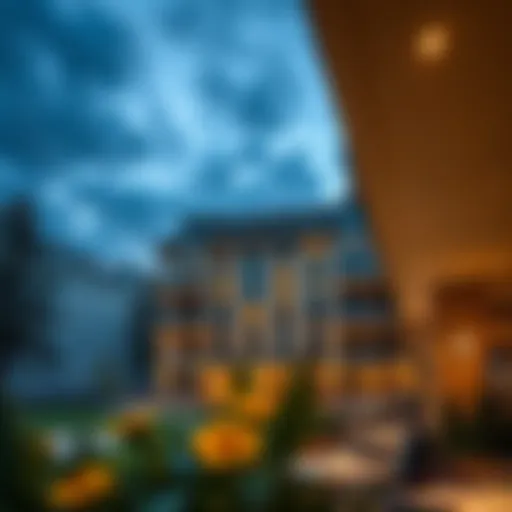Oasis Building: Transforming Dubai's Real Estate
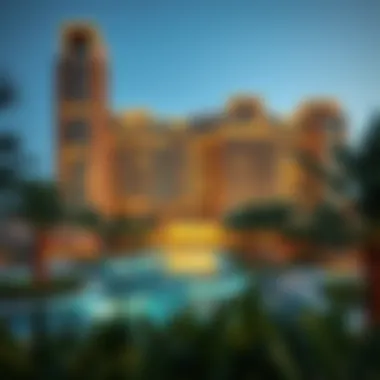

Intro
In the vivid tapestry of Dubai's real estate scene, the notion of oasis building emerges as a captivating concept, blending architectural ingenuity with a commitment to sustainability. This approach aims to craft spaces that not only cater to modern living but also resonate with the intrinsic beauty of the surrounding environment. As the city continues to evolve, the idea of an oasis — often synonymous with tranquility and life — becomes increasingly relevant.
With soaring skyscrapers and bustling markets, the question arises: how can new developments weave natural elements into the urban fabric? Oasis building holds potential to create harmonious living spaces that reflect the cultural and environmental uniqueness of Dubai. This exploration journeys through investment opportunities, market trends, and the principles guiding this innovative movement.
Investment Opportunities
As investors and property managers cast their nets in Dubai’s real estate waters, oasis building offers a distinctive edge. Integrating natural landscapes into developments not only attracts buyers looking for quality living but also symbolizes a commitment to sustainability. This can enhance property values significantly due to increasing demand for eco-conscious living.
Top Neighborhoods for Investment
When it comes to tapping into the oasis concept, certain neighborhoods stand out:
- Dubai Marina: Known for its stunning waterfront views, upcoming projects may soon integrate more green spaces.
- Jumeirah Beach Residence: Properties overlooking the beach, coupled with landscaped gardens, offer a perfect mix of leisure and nature.
- Downtown Dubai: Here, high-end developments like the Burj Khalifa blend nature into luxury, appealing to affluent consumers.
- Arabian Ranches: This community prioritizes green living with spacious villas surrounded by natural reserves.
Upcoming Developments to Watch
Investors should keep an eye on several projects that promise to enhance the oasis theme:
- The Sustainable City: Promises a self-sufficient lifestyle with renewable resources, green spaces, and eco-friendly technologies.
- Mohammed Bin Rashid City: This massive project will emphasize parks and open areas within the urban landscape.
- Dubai Hills Estate: Planning to include more green belts and parks, making it a desirable choice for families.
Market Trends
Keeping a finger on the pulse of the market is crucial for stakeholders in Dubai's evolving landscape. The push toward sustainable living has started to reshape purchasing patterns and demands.
Current Market Analysis
As of now, oasis-style developments witness a positive response. Statistics show that consumers are increasingly willing to pay a premium for homes that offer a balance between urban convenience and natural beauty. With climate change on the horizon, the preference for eco-friendly housing is likely to grow, making these investments more appealing.
Future Projections and Trends
Moving forward, expectations for oasis building suggest an upward trend:
- Sustainable Innovations: Advancements in green technology will allow for even more integration of natural elements into architecture.
- Regulatory Support: The government is likely to bolster initiatives that favor environmentally responsible building practices.
- Rising Demand: As more people move to Dubai, the desire for unique, nature-centric communities will fuel growth in this sector, emphasizing the importance of savvy investments in oasis properties.
"As Dubai pushes toward becoming a global model for sustainability, oasis building will likely play a pivotal role in shaping its urban identity."
Understanding Oasis Building
The exploration of oasis building is crucial in understanding Dubai's ambitious approach to merging nature and architecture within its vast urban landscape. This concept goes beyond mere aesthetics; it intertwines cultural heritage, environmental sustainability, and economic growth into the fabric of the city. By taking a closer look at the principles that guide oasis building, one can appreciate not only its profound significance in Dubai but also its impact on real estate practices and market trends.
Key aspects of oasis building include:
- Symbiosis with Environment: Enhancing urban environments by integrating natural elements, these designs aim to restore ecological balance.
- Cultural Relevance: Reflecting local traditions, the designs echo the history and identity of the region, which can resonate with both local residents and expatriates.
- Practical Benefits: Oasis buildings offer intrinsic advantages such as improved air quality, reduced heat retention, and provision of recreational spaces that promote health and well-being.
In exploring oasis building more thoroughly, one finds itself engaged with questions about the benefits for potential buyers and investors. Is there a market demand for such sustainable living spaces? What hurdles might developers face when trying to implement these concepts? These points stem from the need to understand not just the physical structure but the overarching ideology that fuels such innovative designs, making it pertinent to the discourse surrounding Dubai's ever-evolving real estate landscape.
Design Principles of Oasis Building
The concept of oasis building extends far beyond mere aesthetics; it is a well-thought-out design philosophy that integrates the natural environment with modern architecture. This principle holds particular significance in Dubai, where the relentless sun and arid climate challenge traditional building approaches. The design principles focus on creating comfortable, sustainable living spaces that harmoniously blend with the surroundings. By paying close attention to the integration of natural elements and the use of sustainable materials and techniques, oasis building seeks to create not just buildings but revitalizing habitats within the urban sprawl.
Integration of Natural Elements
Integrating nature into architectural projects is not just a trendy gimmick; it is a fundamental principle of oasis building. This approach encompasses three core aspects: water features, green spaces, and shade elements. Each has its unique contributions to the overall goal of creating a symbiotic relationship between nature and urban life.
Water Features
Water features serve as essential elements in the oasis building concept. They provide not only an element of beauty but also play a crucial role in cooling the surrounding area. The most distinguishing characteristic of these features is their ability to create microclimates. A well-placed fountain or pond can reduce temperatures, making outdoor spaces more livable and attractive.
While natural water bodies are not practical in urban environments, the addition of artificial ponds or reflective panels can provide similar cooling effects. The only downside might be the maintenance required; standing water can attract pests if not handled properly. However, the aesthetic appeal and environmental benefits often outweigh these concerns.
Green Spaces
Green spaces are another hallmark of oasis building in Dubai. They offer a multitude of benefits, including improving air quality, enhancing biodiversity, and providing necessary shade. A crucial characteristic of these spaces is their ability to bring communities together; landscaped parks and gardens often serve as social hubs.
The unique feature of green spaces in oasis design is their versatility; they can range from rooftop gardens to sprawling public parks. However, there can be challenges related to water usage and plant maintenance in Dubai’s dry climate. Still, innovative irrigation systems and the selection of drought-resistant plants mitigate these issues significantly.
Shade Elements
In a city renowned for its intense heat, shade elements are not merely decorative but essential for preserving comfort in urban environments. Structures such as canopies, pergolas, or strategically planted trees make for ideal shade solutions. This principle is especially vital in open areas where sunlight can be unforgiving.
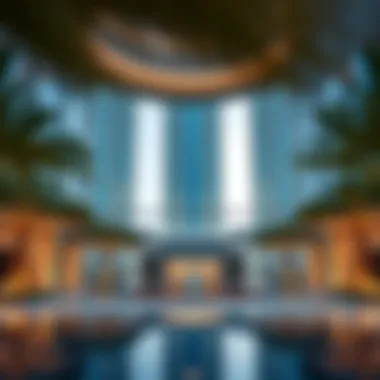

The key characteristic of shade elements is their dual function; they can enhance architectural aesthetics while also providing much-needed relief from sun exposure. The challenge may arise in ensuring that these elements are durable enough to withstand Dubai’s weather extremes, but thoughtful design can easily remedy this, often incorporating local materials known for their resilience.
Sustainable Materials and Techniques
Inextricably linked to the design principles of oasis building is the commitment to using sustainable materials and techniques. By utilizing locally sourced materials, enhancing energy efficiency, and focusing on waste reduction, builders can create structures that not only meet the immediate needs of occupants but also contribute to the long-term sustainability of Dubai's urban landscape.
Locally Sourced Materials
When discussing locally sourced materials, the emphasis is on reducing transport emissions while supporting local economies. regional materials exhibit greater compatibility with the climate, promoting better insulation and energy efficiency.
Local stone, for instance, works exceptionally well in creating thermal mass, a key characteristic that keeps buildings cooler in the daytime heat. The downside is that sourcing materials may sometimes limit design options, but creativity often flourishes under constraints, yielding innovative solutions.
Energy Efficiency
Energy efficiency is paramount in oasis building. Techniques such as passive solar design or efficient HVAC systems can significantly lower energy consumption. The standout aspect of energy efficiency is its cost effectiveness over the long run, reducing utility bills for homeowners and tenants.
It's worth noting that while the initial investment in energy-efficient technology may be higher, the benefits often pay off considerably in terms of savings and comfort. Moreover, urban developments that prioritize energy efficiency are more attractive to environmentally conscious investors.
Waste Reduction
Waste reduction techniques are another pivotal aspect of sustainable construction in oasis building. Employing construction practices that minimize waste production is beneficial for both the environment and construction budget.
Utilizing recycled materials or repurposing existing structures are unique features that stand out in this aspect. While the challenge may lie in the higher upfront costs or the labor involved in recycling processes, the long-term environmental benefits are undeniable and increasingly attractive to both developers and buyers who prioritize sustainability in their investments.
Oasis Building and Urban Planning
The notion of oasis building intertwines closely with urban planning in Dubai, where the clash between rapid urban development and the preservation of cultural heritage unfolds daily. This concept embodies more than just aesthetic appeal; it aims to harmonize the built environment with the soul of the city. Oasis building schemes focus on infusing natural elements into urban settings, heightening both the visual and functional aspects of communal spaces. Such integration is vital for fostering a sense of place that reflects the unique characteristics of Dubai’s arid environment, while also addressing the pressing need for sustainable urban solutions.
Enhancing Urban Aesthetics
Aesthetics in urban environments can often be an afterthought, overshadowed by the desire for immediate functionality. However, oasis building shifts this paradigm, prioritizing visual appeal alongside utility. By incorporating lush green spaces, water features, and shaded areas, oasis buildings not only beautify the city but also enhance residents' experiences.
In Dubai, where stark concreted landscapes dominate, these thoughtfully designed spaces can create a striking contrast, inviting people to enjoy their surroundings. The calming effects of nature play a significant role in urban settings, offering reprieve from bustling city life. Moreover, well-designed open spaces can serve as landmarks, attracting both locals and visitors, thus contributing to the city’s tourism economy.
Influence on Community Development
Community development is at the heart of oasis building. Urban planners and architects aim to create environments that transcend mere residential units, fostering a genuine sense of belonging and connection among residents.
Creating Gathering Spaces
Creating gathering spaces is essential for building community ties. These areas are where friendships bloom and cultural exchanges take place. Equipped with benches, gardens, and art installations, gathering spaces allow community members to interact and forge relationships. This kind of design promotes not just leisure, but also social cohesion.
The key characteristic of these spaces is their accessibility. Well-located gathering areas tend to draw a diverse range of individuals, making them a hub of activity. As people congregate, they share experiences, which can lead to robust community networks. However, their success largely depends on proper management and maintenance, underscoring the continuous commitment required from local authorities.
Encouraging Local Engagement
Encouraging local engagement is another critical aspect of oasis building that underpins community growth. By providing platforms for residents to partake in local governance, decision-making, and cultural initiatives, oasis buildings can empower individuals to influence their habitats positively.
The unique feature of this engagement is its grassroots nature. Community-led initiatives can take on various forms, from hosting farmer's markets to open-air film screenings. These activities not only foster a sense of ownership but also stimulate economic prospects for local businesses. Furthermore, this participatory approach can help ensure that developments resonate more profoundly with cultural contexts. The challenge lies in not just initiating these engagements but sustaining them over time, adapting to community needs as they evolve.
The fusion of oasis building with urban planning in Dubai epitomizes a forward-thinking approach, emphasizing a community-centered vision.
In summary, oasis building in Dubai is more than an architectural trend; it is a framework for urban planning that enhances aesthetics, fosters community development, and promotes sustainable interaction. As this concept continues to evolve, it holds the potential to reshape not just the skyline, but also the very fabric of city life.
Environmental Impact of Oasis Building
The environmental impact of oasis building in Dubai's real estate scene is a pivotal consideration when examining this innovative architectural approach. These structures aim to create a balance between urban civilization and natural ecologies, offering a model for sustainable development amidst a desert landscape. They not only provide aesthetic pleasure but also host critical environmental benefits that align with Dubai’s aspirations for a greener future.
Promoting Biodiversity
One significant advantage of oasis building is its potential to promote biodiversity within urban settings. By integrating features such as native flora and fauna, these developments create habitats that naturally attract wildlife, thereby enriching local ecosystems. The use of indigenous plant species not only enhances the aesthetic quality of the spaces but also supports resilience against diseases and pests that could afflict more traditional landscaping.
Incorporating water features, such as ponds or streams, provides an essential resource for various species, fostering an environment where animals and plants can thrive. For instance, projects that include wetland areas encourage the presence of birds, insects, and other wildlife, all of which play a critical role in the ecological balance. Moreover, these features can act as natural filtration systems, helping to maintain water quality and manage stormwater effectively.
"The introduction of green spaces within urban environments doesn’t just beautify the area; it serves as a crucial step in fostering sustainable biodiversity."
Reducing Urban Heat
Another crucial environmental benefit of oasis building is its effectiveness in reducing urban heat, a pressing issue in desert cities like Dubai. Urban heat islands typically emerge when natural landscapes are replaced by concrete and asphalt. Oasis buildings strategically counteract this phenomenon by seamlessly incorporating greenery and water elements into their designs.
Vegetation naturally cools the air through a process called evapotranspiration, where plants release water vapor into the atmosphere. This can result in noticeably lower temperatures in and around these oases compared to the surrounding areas. Additionally, shade elements such as canopies and green roofs play a vital role in minimizing heat absorption and enhancing thermal comfort for residents.
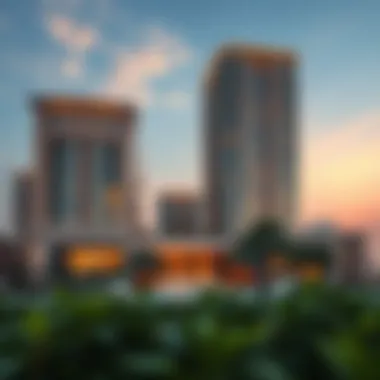

In practical terms, this leads to lower energy consumption as buildings require less air conditioning during the hotter months. Consequently, reducing reliance on energy-intensive cooling systems not only lowers utility bills for occupants but also contributes to decreased carbon emissions, supporting broader climate goals.
In summary, the environmental impact of oasis building in Dubai is multi-faceted. By prioritizing biodiversity and reducing urban heat, these developments exemplify a forward-thinking approach to architecture that aligns with both ecological health and urban livability.
As the trend towards oasis building grows, it represents not only an aesthetic revolution but a commitment to sustaining the environment in harmony with modern developments.
Economic Implications of Oasis Building
Oasis building in Dubai is not just an architectural trend; it's a strategic approach that impacts the economy of the entire region. The integration of natural elements into urban design creates a unique selling proposition for real estate developers, enabling them to tap into a market increasingly focused on sustainability and aesthetics. The economic implications of this concept are far-reaching, affecting everything from investment flows to long-term urban viability.
With their emphasis on harmony with nature, oasis buildings have great potential to increase property value. Buyers and investors are increasingly gravitating towards developments that offer green spaces and environmental benefits. This has led to a notable shift in real estate investments, where the demand for eco-friendly buildings is on the rise. Additionally, properties with attractive oasis-like features tend to experience lower vacancy rates, a vital sign of economic health.
Investment Opportunities
The burgeoning interest in oasis building has ushered in a plethora of investment opportunities for savvy stakeholders in the Dubai real estate market. Investors are now looking for developments that offer not just a home, but a lifestyle, intertwining leisure, sustainability, and community living.
- Residential Developments: Properties designed with integrated natural elements often command premium prices and appeal to investors seeking long-term gains. The added value from features like gardens, artificial lakes, and shaded areas can enhance the overall marketability.
- Commercial Spaces: Oasis-like office spaces can attract businesses that prioritize employee well-being and work-life balance. Companies are increasingly aware that their workplace environments influence productivity and morale, making these spaces crucial for attracting top talent.
- Tourism and Leisure: The lure of well-designed, nature-integrated environments has implications for tourism. Luxury developments that blend nature with upscale amenities can draw tourists and increase foot traffic for local businesses, contributing to economic vitality.
Market Trends and Future Outlook
As the real estate landscape continues to evolve, the future of oasis building seems bright, to say the least. Current trends indicate a movement towards sustainable living spaces that cater to an environmentally conscious populace.
- Sustainability as a Priority: More developers are embracing sustainability in their projects, with an eye towards minimizing environmental footprints. Green building certifications are becoming a norm, appealing to forward-thinking investors.
- Integration of Technology: Smart technology is making its way into many oasis building projects, allowing for enhanced energy efficiency and better resource management. This tech-savvy approach can attract a new demographic of buyers who are technologically inclined.
- Adaptive Reuse of Spaces: The conversion of old structures into modern oasis buildings is becoming popular. It represents a blending of tradition and modernity, creating unique opportunities for investment in not just new builds, but also in historic refurbishments.
"Investors are recognizing that those who adapt to sustainability trends will lead the market in the years to come."
Challenges in Implementing Oasis Building Concepts
Building an oasis in the bustling cityscape of Dubai sounds picturesque, yet it poses a series of intricate challenges. Understanding these hurdles is imperative for investors and developers seeking to bring the concept of oasis building to life.
Regulatory frameworks can sometimes act like thick fog, obscuring the pathways to innovation. Local regulations and building codes might not always align with the creative visions of architects looking to integrate natural elements into urban designs. There’s a tale of a developer who had a stunning design for a multi-use building crowned with greenery. However, due to stringent zoning laws, adjustments were necessary that diluted the overall concept. This often leads to a compromise between intention and execution.
Moreover, community engagement is vital yet complex. Building an oasis isn't just about planting trees and setting up water features; it’s about cocreating a space that resonates with the local populace. Engaging stakeholders, from residents to local businesses, involves in-depth discussions and sometimes, heated debates. If these conversations don’t happen early on, projects can face backlash or even rejection from the community they aim to serve.
Financial viability is another knot in the thread of oasis building. Investors naturally want to see returns, but sometimes the cost of sustainable materials or innovative designs exceeds initial budgets. Finding the right balance often demands creative financial strategies that might stretch the limit of traditional real estate investing.
"Sustainable buildings often require a leap of faith, demanding not only vision but also meticulous planning."
Understanding these components facilitates a complete view of what it takes to materialize an oasis in Dubai's thriving real estate market. Tackling challenges like regulatory hurdles and the need to harmonize modernity with local traditions is essential to any successful project, laying the groundwork for vibrant, sustainable communities.
Regulatory Hurdles
Navigating the regulatory landscape is akin to traversing a high-stakes maze, fraught with limitations but also laden with potential. Every city has its regulations, but Dubai's are particularly intricate, designed to maintain a level of uniformity while promoting growth. Developers might need to align their visions with the existing framework laid out by Dubai's Urban Planning Council.
When a developer attempts to introduce innovative features—like unique water retention systems or vertical gardens—they must ensure compliance with both safety regulations and aesthetic standards. Each step must be meticulously charted to avoid fines or costly redesigns, making foresight and preparation invaluable assets.
Communicating with regulatory bodies early on ensures a smoother process. Developers may find it beneficial to consult with local experts who can guide them through potential pitfalls and help hone their designs to fit the rules.
Balancing Modernization with Tradition
In a city like Dubai, where ultra-modern skyscrapers dot the landscape, tradition remains an integral part of the architectural conversation. Balancing the two isn’t just a matter of aesthetics; it’s a delicate dance that acknowledges history while welcoming innovation.
Many oasis building efforts try to reflect local heritage, blending natural elements with designs that speak to the cultural narrative of the region. For instance, incorporating calligraphy or traditional patterns into the landscaping can resonate deeply with the community. But this is where tension often arises.
A potential conflict could emerge when contemporary designs clash with established cultural practices. Consider a project that utilizes modern glass facades alongside traditional plaster work; if not handled carefully, it might send mixed messages about the community’s cultural identity. Meeting this challenge calls for a collaborative approach—engagement with historians or community leaders can ensure that the new complements the old rather than overshadow it.
Ultimately, implementing oasis building concepts in Dubai requires a nuanced understanding of the complex layers involved—from regulatory frameworks to community sentiment. Successfully navigating these challenges not only results in aesthetically stunning developments but also fosters communities that embrace both tradition and innovation.
Case Studies: Successful Oasis Building Projects in Dubai
Understanding practical examples of oasis building serves a pivotal role in comprehending the broader implications within Dubai's real estate market. Case studies highlight how theoretical concepts translate into tangible designs that are not just visually appealing but also environmentally conscious and community-oriented. These successful projects provide a roadmap for future developments and showcase the multifaceted benefits of integrating natural elements into urban spaces.
Project A Overview
Design Elements
One striking feature of Project A is its clever use of modular design elements, which allow for flexibility and expansion. This design approach creates an inviting atmosphere while addressing the harsh climate. The project utilizes wind-funnels to enhance natural airflow, minimizing reliance on air conditioning — a key characteristic highly valued in Dubai's soaring temperatures. The incorporation of solar panels on roofs captures sunlight for energy production, underscoring the commitment to sustainability.
One unique aspect of these design decisions lies in their ability to produce a dual benefit: they not only minimize energy costs but also enhance the aesthetic appeal of the structures. This fusion makes Project A a benchmark for future oasis initiatives in Dubai.
Community Impact
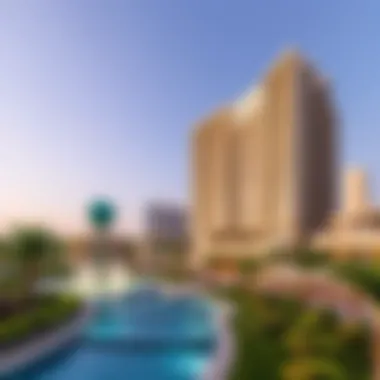

The community impact of Project A is profound. By prioritizing public gathering spaces, the project fosters a sense of belonging among residents. The inclusion of shaded plazas and garden pathways encourages informal interaction, drawing people outside of their homes and nurturing social networks. This characteristic is particularly beneficial because it supports local culture and promotes community engagement.
Moreover, the project's design enables diverse recreational activities, from artisanal markets to outdoor movies. Such features help local businesses thrive and create a supportive environment for residents to connect. It thus amplifies the sense of community, making Project A a pivotal case study for effective oasis building.
Project B Overview
Design Elements
Project B adopts an innovative approach by integrating vertical gardens into its façade. This specific element contributes not only to the increase in green coverage but also enhances air quality within the vicinity. The use of drought-resistant plants ensures that these green spaces are sustainable, adapting seamlessly to the local environment.
Additionally, reflective surfaces are employed to reduce heat absorption, ensuring that the building remains cool without excessive use of artificial cooling methods. The unique combination of these two design features allows Project B to stand out, making it a desirable choice for environmentally conscious buyers.
Economic Benefits
The economic impact of Project B is noteworthy. The emphasis on smart building technologies enhances property values by attracting tech-savvy investors interested in sustainable living options. Its design not only boosts energy efficiency but also reduces operational costs for homeowners. Moreover, through innovative land use, Project B has experienced increased property taxes benefiting local infrastructure.
Local businesses have reported higher foot traffic due to the aesthetic appeal of Project B, resulting in a positive economic ripple effect throughout the area. Such economic benefits underscore the strategic importance of adopting oasis building principles within the broader context of Dubai's personality-driven market.
Integrating natural elements into urban design is not just a trend; it is a transformative journey towards sustainability and community cohesion.
The Role of Technology in Oasis Building
In today’s rapidly evolving world, technology has become a cornerstone in shaping sustainable architectures like oasis buildings in Dubai. The intersection of tech and design creates efficiencies that not only enhance the experience for inhabitants but also address environmental concerns. As investors and developers strive to create livable spaces that harmonize with nature, the role of technology emerges as an essential consideration.
Smart Building Solutions
Smart building solutions are revolutionizing the way oasis architecture operates, making it more than just a feast for the eyes. These systems integrate IoT (Internet of Things) devices that allow real-time monitoring and control of various building functions. For instance, smart sensors can track indoor air quality and adjust ventilation accordingly.
- Energy Management: Automated systems control lighting and HVAC (heating, ventilation, and air conditioning) based on occupancy, leading to significant energy savings.
- Water Conservation: Smart irrigation systems manage water usage in green spaces, ensuring that plants receive adequate hydration without wastage.
Implementing these technologies not only reduces the operational costs but also adds value to the properties, making them attractive investments in a competitive market. Technology affords developers the ability to build adaptable spaces that can evolve over time.
Innovations in Sustainable Design
The push for greener construction methods aligns perfectly with the ethos of oasis building. Recent innovations in sustainable design showcase how technology can lead to lower environmental footprints.
- Advanced Materials: Utilization of green materials, like recycled steel and low-emission concrete, is on the rise. These materials not only reduce waste but also have a longer lifespan, minimizing the need for future replacements.
- Solar Solutions: Incorporating solar panels is more than an option; it has become necessary. Buildings embedded with photovoltaic cells can harness the sun’s energy, significantly lowering electricity costs.
- Planned Microclimates: Through careful strategic placement and the use of technology, developers can create microclimates within developments that offer cooler environments. This enhances the outdoor experience while reducing reliance on air conditioning.
The integration of technology in oasis building highlights the necessity of forward-thinking approaches that engage with not just the aesthetic elements but the functional ones as well. This synergy between tech and design leads to more robust, resilient community spaces.
As Dubai’s skyline continues to morph, understanding the role of technology in oasis building is key for stakeholders aiming to contribute to this dynamic landscape. Ultimately, these technological advancements are not merely luxuries; they are becoming vital threads in the tapestry of sustainable urban development.
Public Perception and Community Involvement
The success of oasis building concepts in Dubai hinges significantly on public perception and community involvement. Often, these developments aren't just about bricks and mortar; they represent a deeper expectation and a vision from residents. When communities are actively engaged in the conceptualization and execution of these projects, it ensures that the outcome resonates with their needs and desires. Factors like aesthetic appeal, recreational opportunities, and environmental considerations not only enhance quality of life but also foster a sense of belonging among residents.
Local Stakeholder Engagement
For oasis building initiatives to flourish, it is crucial to involve local stakeholders right from the planning phase. Stakeholders include a wide array of individuals: local businesses, community groups, architects, and even residents. Their input can guide developers to create spaces that are not only functional but that also speak to the cultural and social fabric of the community. When developers conduct community workshops or surveys, they open up dialogues that allow residents to voice their concerns and suggestions.
Moreover, aligned interests between builders and local stakeholders can lead to innovative solutions that address specific community challenges. For instance, if a community highlights a need for more green spaces, developers can adjust their designs to include parks or gardens that serve both aesthetic and ecological purposes. This partnership not only enriches the project but also builds trust and transparency, making residents feel valued in the decision-making process.
Feedback Mechanisms for Future Developments
Another cornerstone of fostering positive public perception is establishing effective feedback mechanisms. After the initial development phase, ongoing communication with community members is vital. This can take numerous forms, from public forums to online platforms where residents can leave thoughts and experiences regarding the developments in their area.
Residents often have invaluable insights into how a space performs after it’s been built – from pedestrian traffic patterns to suggestions on additional amenities. Collecting this real-time feedback can influence future projects, ensuring they evolve in a way that aligns with community needs. Additionally, these feedback mechanisms create avenues for residents to feel heard and foster a culture of participation.
Incorporating community feedback shows that the developers and city planners are not just top-down decision-makers but are keen on nurturing a collaborative environment. This strategy not only helps refine ongoing projects but also enhances the positive reception of future initiatives, emphasizing that community involvement leads to well-rounded and sustainable oasis projects.
"Engaging the community isn't just an afterthought; it's a fundamental ingredient in successful oasis building."
Future Prospects of Oasis Building in Dubai
The idea of oasis building in Dubai's real estate scene is not just a fleeting trend; it represents a fundamental shift in how spaces are conceived and utilized. As urbanization surges, stemming from rapid population growth and economic expansion, the sensitivity towards sustainable living is becoming of utmost importance. Oasis buildings embody both a fusion of conservation and innovation, promising a more harmonious relationship between nature and architecture. Understanding the future prospects aids investors, property managers, and agents in grasping the potentials and challenges that lie ahead.
Predicted Trends in Real Estate
As the landscape of real estate continually evolves, several key trends related to oasis building are beginning to emerge:
- Heightened Demand for Green Spaces: With the ongoing realization of health benefits associated with natural environments, developers are increasingly focusing on integrating parks, gardens, and water features into new projects. This trend draws attention not only from local buyers but also from international investors who seek more sustainable living solutions.
- Integration of Smart Technology: The application of smart technology within oasis buildings, like energy-efficient systems or automated irrigation, is on the incline. This not only enhances the functionality of residential areas but also provides a competitive edge in the market.
- Influence of Urban Planning Regulations: Governments are forging ahead with policies that encourage sustainable development practices. This could mean more regulations favoring oasis principles, creating a compliant yet flourishing market.
- Revival of Community-Centric Developments: In the race to create livable downtown areas, there's a growing emphasis on community-first strategies. Oasis buildings can create gathering spots that foster interaction among residents.
Emerging Influences on Design
The design landscape of oasis buildings is shifting as newer influences come into play:
- Culturally Inspired Designs: There’s a notable trend towards infusing local cultural elements into the architecture of oasis buildings. This not only preserves cultural heritage but also attracts buyers who appreciate the uniqueness of their homes. Incorporating traditional design with modern functionality can craft spaces that resonate with both locals and expatriates alike.
- Sustainability at the Forefront: New materials and architectural techniques that push for sustainability are gaining traction. From renewable resources to biodegradable materials, designers are tasked to create spaces that lessen environmental footprints. This reimagining of traditional designs with sustainable methods transforms the essence of oasis architecture.
- Collaboration with Nature: A paradigm shift towards allowing nature to dictate design is taking hold. Buildings are now being designed to not only withstand climatic elements but to work in harmony with them. Roofs adorned with vegetation can provide insulation while simultaneously adding aesthetic value.
- Influence of Global Trends: In an interconnected world, global designs are settling into Dubai’s architectural vernacular. The international appeal of oasis buildings is bolstered by movements towards minimalist designs, clean lines, and multifunctional spaces that appeal to discerning buyers.
In sum, the future of oasis building in Dubai is an exciting realm filled with potential. Through adapting to the changing dynamics of real estate trends and embracing the influences of sustainability and culture, a robust market will emerge that caters to both present and future generations. For investors and property managers, the horizon looks promising as they explore opportunities that arise from these inevitable changes.
